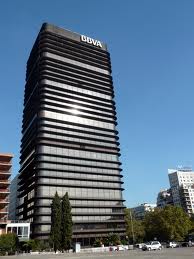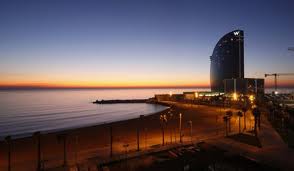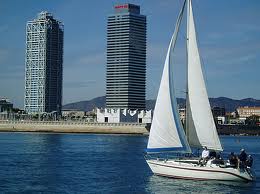Spanish Architecture: Skyscrapers

Following the death of General Francisco Franco in 1975, Spain entered a period known as the 'transition' towards democracy, which corresponds to a political and social period of adaptation to the emerging structures. In architectural terms, however, and perhaps at more profound levels than evident at first, the transition began long before the end of the dictatorship, with the erection of the first skyscrapers.
Towards the end of the 1960s starts a tendency to develop a vertical urbanism that would only be strengthened during the dying days of the dictatorship. For instance, in 1971 the famous architect Francisco Sáenz de Oiza, already prominent due to his development of the 'Torres Blancas', would also develop the skyscraper belonging to the BBVA bank in AZCA, Madrid.
Included to this day in every city guide of Madrid, the tower was 29 floors high and broke the 100 metre threshold, surpassing it by 8 metres. The erection of the square building entailed major engineering issues, as it essentially stands over a tunnel. The square where it is located would later become the hive of high-rise buildings in the city, until it was moved further to the west almost thirty years later.
Ricarddo Bofill

While the proliferation of skyscrapers in Spain became a dominant fashion, it was by no means the only popular tendency in the country. In Barcelona, for instance, Ricardo Bofill developed a theory that can still be witnessed today, if you pass by the city or go to learn Spanish in Barcelona. It was the emergence of what he termed 'La ciudad del espacio' (the city of space), through which he enunciated his solution to the issues of space and habitability.
Rather than pumping concrete into various towers, Bofill sought to develop an organic solution to the problem, exploiting to the maximum various spaces fit for living and ultimately coming up with an complex structure of multiple levels in unorthodox shapes. It is the Walden 7 apartment building, a compact and striking housing complex that, unbelievably, is home to 1000 families.
Bofill is part of the generation of novel architects who have carried out the majority of their trade in the of Democracy in Spain, and who have helped to bring the country back into the fold of things in the XXI century.
Oriol Bohigas
Another influential architect, particularly around the region of Barcelona, is Oriol Bohigas. One of the most respected figures in the establishment, he has been active since the early 1960s. He associated himself with another prominent Catalonian architect, Josep Martorell in the creation of the joint MBM Arquitectes company (the other M corresponds to the third partner, David Mackay).

The firm was awarded one of the most important assignments that had been available until that point in Spain: the design and development of the 'Vila Olimpica' of Poble Nou in Barcelona for the Olympic Games of Barcelona in 1992. One of the sites where the Olympic Games were to take place, the Vila brought about a great project of regeneration to aa part of the city which had been left undeveloped for a long time.
Thus, the ambitious project not only had to provide a sports hall and a suitable marina for a number of events related to the Olympic Games to take place, but it also had an urban element that played an essential role in the planning of the layout. The final result is there to be enjoyed by anyone who might travel to Barcelona, with the impressive two skyscrapers that are the Torre Mapfre, for a long time the second tallest building in Spain, and the Hotel Arts.
Which leaves us with the question: what was the tallest building in Spain at the time, then, if the Mapfre Tower was the second tallest? It was the Picasso Tower in Madrid, started in 1982, finished in 1988 and located in the vicinity of other skyscrapers in the capital, such as the BBVA Tower. The Picasso Tower dwarfed the latter by almost 50 metres, and it immediately became an unmistakable landmark of Spanish architecture - expect it was designed by Japanese-American architect Minoru Yamasaki.
It was the birth of a new trend in Spanish architecture, totally pertinent only to the age of democracy, as foreign architects and architectural firms turned their gaze in the direction of the booming Spanish market. And so, the trend was set for the new millennium.
